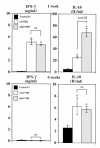Role of perforin in controlling B-cell hyperactivity and humoral autoimmunity
- PMID: 10995792
- PMCID: PMC381389
- DOI: 10.1172/JCI8876
Role of perforin in controlling B-cell hyperactivity and humoral autoimmunity
Abstract
To determine the role of perforin-mediated cytotoxic T lymphocyte (CTL) effector function in immune regulation, we studied a well-characterized mouse model of graft-versus-host disease (GVHD). Induction of acute GVHD using perforin-deficient donor T cells (pfp-->F1) initially resulted in features of acute GVHD, e.g., engraftment of both donor CD4(+) and CD8(+) T cells, upregulation of Fas and FasL, production of antihost CTL, and secretion of both Th1 and Th2 cytokines. Despite fully functional FasL activity, pfp donor cells failed to totally eliminate host B cells, and, by 4 weeks of disease, cytokine production in pfp-->F1 mice had polarized to a Th2 response. Pfp-->F1 mice eventually developed features of chronic GVHD, such as increased numbers of B cells, persistence of donor CD4 T cells, autoantibody production, and lupuslike renal disease. We conclude that in the setting of B- and T-cell activation, perforin plays an important immunoregulatory role in the prevention of humoral autoimmunity through the elimination of both autoreactive B cells and ag-specific T cells. Moreover, an ineffective initial CTL response can evolve into a persistent antibody-mediated response and, with it, the potential for sustained humoral autoimmunity.
Figures





Comment in
-
Revisiting graft-versus-host disease models of autoimmunity: new insights in immune regulatory processes.J Clin Invest. 2000 Sep;106(6):745-7. doi: 10.1172/JCI11088. J Clin Invest. 2000. PMID: 10995784 Free PMC article. No abstract available.
Similar articles
-
Differential expression of Fas and Fas ligand in acute and chronic graft-versus-host disease: up-regulation of Fas and Fas ligand requires CD8+ T cell activation and IFN-gamma production.J Immunol. 1998 Sep 15;161(6):2848-55. J Immunol. 1998. PMID: 9743345
-
CTL-Promoting Effects of IL-21 Counteract Murine Lupus in the Parent→F1 Graft-versus-Host Disease Model.J Immunol. 2016 Feb 15;196(4):1529-40. doi: 10.4049/jimmunol.1501824. Epub 2016 Jan 20. J Immunol. 2016. PMID: 26792801
-
Kinetics of Th1 and Th2 cytokine production during the early course of acute and chronic murine graft-versus-host disease. Regulatory role of donor CD8+ T cells.J Immunol. 1995 Sep 1;155(5):2396-406. J Immunol. 1995. PMID: 7650373
-
Th2 and Tc2 cells in the regulation of GVHD, GVL, and graft rejection: considerations for the allogeneic transplantation therapy of leukemia and lymphoma.Leuk Lymphoma. 2000 Jul;38(3-4):221-34. doi: 10.3109/10428190009087014. Leuk Lymphoma. 2000. PMID: 10830730 Review.
-
Unique site of autoantibody production in Fas-deficient mice.Ann N Y Acad Sci. 1997 Apr 5;815:218-29. doi: 10.1111/j.1749-6632.1997.tb52063.x. Ann N Y Acad Sci. 1997. PMID: 9186658 Review.
Cited by
-
Expansion of CD4+ T cells with a cytotoxic phenotype in patients with B-chronic lymphocytic leukaemia (B-CLL).Clin Exp Immunol. 2001 Oct;126(1):29-36. doi: 10.1046/j.1365-2249.2001.01639.x. Clin Exp Immunol. 2001. PMID: 11678896 Free PMC article.
-
Enhancement of suboptimal CD8 cytotoxic T cell effector function in vivo using antigen-specific CD80 defective T cells.J Immunol. 2011 Jan 1;186(1):291-304. doi: 10.4049/jimmunol.0902370. Epub 2010 Nov 29. J Immunol. 2011. PMID: 21115734 Free PMC article.
-
Proteasome inhibition and allogeneic hematopoietic stem cell transplantation: a review.Biol Blood Marrow Transplant. 2009 Dec;15(12):1502-12. doi: 10.1016/j.bbmt.2009.07.016. Biol Blood Marrow Transplant. 2009. PMID: 19896073 Free PMC article. Review.
-
Cytolytic T cells induce ceramide-rich platforms in target cell membranes to initiate graft-versus-host disease.Blood. 2009 Oct 22;114(17):3693-706. doi: 10.1182/blood-2008-11-191148. Epub 2009 Aug 7. Blood. 2009. PMID: 19666872 Free PMC article.
-
Association of Viral Infection With the Development and Pathogenesis of Systemic Lupus Erythematosus.Front Med (Lausanne). 2022 Feb 25;9:849120. doi: 10.3389/fmed.2022.849120. eCollection 2022. Front Med (Lausanne). 2022. PMID: 35280878 Free PMC article. Review.
References
-
- Millard PJ, Henkart MP, Reynolds CW, Henkart PA. Purification and properties of cytoplasmic granules from cytotoxic rat LGL tumors. J Immunol. 1984;132:3197–3204. - PubMed
-
- Clark WR, et al. Molecular pathways of CTL-mediated cytotoxicity. Immunol Rev. 1995;146:33–44. - PubMed
-
- Kagi D, et al. Cytotoxicity mediated by T cells and natural killer cells is greatly impaired in perforin-deficient mice. Nature. 1994;369:31–37. - PubMed
Publication types
MeSH terms
Substances
Grants and funding
LinkOut - more resources
Full Text Sources
Molecular Biology Databases
Research Materials
Miscellaneous

